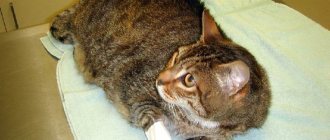Fortunately, it is only necessary to bandage a cat in a few, exceptional cases. The general rule is that bandaging a cat by the owner is nothing more than the first emergency aid to stop intense bleeding, close a penetrating wound into the chest, provide support or limit mobility in case of damage to the paws or tail.
Most bandages used by doctors and veterinarians are made from stiff, loosely woven cotton thread of the required length. However , for those who do not have the skills to apply a bandage, it is better to use an elastic analogue - it is easy to apply and it stays in the right place better. There is less chance of the bandage loosening here; fastening is done with a safety pin. The most suitable bandages for cats are 5 centimeters wide. (Of course, in a pinch, any material will do: a handkerchief, a dress belt, a scarf, a tie, a strip of fabric.)
If the cat is not unconscious, you will need to limit its mobility - this can be done on the table with the participation of an assistant who will hold it by the scruff of the neck, while you apply a bandage.
Before you begin the procedure, unwind only a few centimeters of the bandage; leave the rest wound up. Starting with the unrolled part that overlaps the area near the injured part, gradually wrap the bandage around the injured part of the body, unraveling the skein as you do so. If we are talking about a paw or tail, start bandaging from the part that is furthest from the body and gradually bandage towards the body. The second turn of the bandage should completely overlap the first; after that, each next one should overlap two-thirds of the previous one. When it is necessary to apply a bandage to the chest or abdomen, with each new turn a skein of bandage is passed around the entire body.
Typically, the tension on the bandage should be only moderate to prevent it from loosening. However, if a bandage is being used to stop bleeding, it may need to be tight to be more effective. However, make sure that the bandage is not too tight . Otherwise, it can act like a tourniquet and stop blood circulation, and if it is on the neck, it can affect the cat's breathing. To hold the bandage more firmly, after every two or three turns the bandage is turned over so that its inner surface becomes the outer surface, and vice versa (the tension of the bandage is not weakened); this is called spiral bandaging.
It does not matter in which direction the bandaging is performed - clockwise or counterclockwise, it is a matter of habit and depends on whether you are left-handed or right-handed. Having bandaged the damaged area and made several turns outside it, the bandage is cut off and pinned with a pin. But often, in order to keep the bandage intact, it is advisable to place another bandage around the first bandage and then pin it with a safety pin. Make sure she doesn't accidentally prick the cat.
Inspect the end of the bandaged paw or tail from time to time, looking for any signs of swelling that indicate the bandage is too tight. This often happens if the bandage is initially soaked in blood and then dries out. It is necessary to make two cuts of the bandage on top and bottom 1 cm along the animal’s body. If the bandage is too loose, it should also be removed immediately and a new, tighter one applied. However, bandaging yourself is usually only required in exceptional cases, and if you need to regularly perform this procedure, it is better to consult a doctor.
How to bandage a cat's paw, bandaging technique
We learn how to properly bandage a cat's paw.
How to bandage a paw - Most often, as a result of an accident, cats are bandaged on their paws, and in order not to constantly consult a doctor and not disturb the animal (it is a well-known fact that cats do not like visiting a veterinary clinic), it is advisable to learn how to change the bandages yourself. The bandage on the paws most often gets dirty and wet. By the way, this is the easiest bandage to remove from a cat’s paw.
The bandaging technique described below can be used for any injury.
If you have an assistant, then let him hold the cat, but if there is no assistant, then you can handle this procedure yourself. But you will have to do the whole operation with one hand, and hold the cat with the other; you can lightly squeeze the cat between your knees, but do not overdo it.
♦ Prepare a bowl of warm water, hold the cat, place the paw in the bowl and lightly rinse the injured paw. You can also use an antiseptic solution. If blood starts to flow from the wound, immediately remove the paw and bandage it to stop the bleeding.
♦ Gently dry the paw, trying to dry it as much as possible. Then apply a tampon soaked in a special composition (ointment) to the wound (bleeding or weeping). The veterinarian will tell you the composition or ointment based on your wound. The tampon should not stick to the wound.
♦ Place small pieces of cotton wool on the cat's toes and then wrap the cotton wool around the cat's paw. The cotton bandage should reach approximately the middle of the cat's paw and be about two centimeters thick. This layer can protect the paw from being squeezed when you bandage it.
♦ Apply a bandage using a bandage. First wrap the bandage around each finger and then around the cat's wrist. Don't forget to leave a cotton collar over the bandage.
You can use an adhesive plaster instead of a bandage. Although the patch is more convenient for bandaging, especially if you change the bandage yourself, you should not forget that the patch can stick to the cat’s fur, which means additional pain when removing the bandage.
After bandaging, observe the cat to see if the cat can move its paw.
Health to you and your pet.
Source: “Your cat’s health” Samizdat 2010
How to bandage a cat's paw?
It is necessary to bandage a cat only in some exceptional cases.
The main rule is this: bandaging a cat by its owner is nothing more than the first urgent aid in order to close a penetrating wound in the chest, stop severe bleeding, and limit mobility if the paws or tail are damaged. The bandages used by doctors and veterinarians are made of solid cotton thread. But for those who do not have the skills to apply a bandage, it would be best to use an elastic analogue, because it is easier to apply and it will stay much better in the place where it is required.
The likelihood of the bandage coming loose is reduced by securing it with a safety pin. The most suitable bandages for cats are those that are 5 centimeters wide.
But how to bandage a cat's paw when there is no bandage at hand? Any material can be suitable: a dress belt, a handkerchief, a tie, a scarf, a strip of fabric. It is necessary to limit the cat's mobility, if it is not in an unconscious state, this can be done on the table together with an assistant who needs to hold it by the scruff of the neck while the owner applies a bandage.
Before you begin this procedure, you need to unwind just a little bit of the bandage and leave the rest rolled up. You need to start with the unwound part, applied to the area next to the damaged one, gradually wind the bandage around the wounded part of the body, gradually unraveling the skein.
It is worth starting to bandage from the part that is more distant from the body, and gradually moving towards the body - if the cat has a sore paw or tail. It is necessary that the second turn of the bandage completely overlaps the first. Then, each next one should cover two thirds of the previous one. If you need to apply a bandage to the stomach or chest, with each new turn a skein of bandage must be passed around the entire body.
We invite you to read the Instructions for use of the drug Duphalac for cats
The tension of the bandage should be only moderate in order to prevent it from loosening. Although in cases where a bandage is used to stop bleeding, it should be tight to be more effective.
But you should pay attention to the fact that the bandage is not too tight, otherwise it will act like a tourniquet and stop blood circulation, and if it is on the cat’s neck, it will affect its breathing.
The question arises: how to quickly treat a cat’s wound?
In this situation, the main thing is not to get confused and provide first aid to your mustachioed injured cat with just one remedy - a liquid bandage for healing wounds.
You will not have to :
- disinfect the wound;
- treat it with wound-healing ointment;
- then apply a tight bandage.
Moreover, all this may not be at hand. And the beast itself will try to rip it off. To prevent this from happening, some owners strengthen the bandage with tape or tape, which disrupts air exchange and makes healing difficult. It’s wrong to do this, and a real beast will always strive to rip off other things.
Pain relief for cats
Most injuries cause the cat to experience severe pain. The owner can independently reduce it by using pain relief therapy. Special veterinary drugs ketofen or nalbuphine are well suited for this purpose. But it is better not to give such popular painkillers as baralagin and analgin, especially in tablet form, to a cat, because they cause severe salivation in the animal. As a last resort, you can inject analgin by injecting 0.4 ml intramuscularly (dose for an average cat).
Also, in case of injury, traumatic shock is possible, one of the manifestations of which is vasospasm. This spasm has a very bad effect on the liver and kidneys. It can be removed with anti-shock therapy. The affected animal should be given corticosteroid drugs, for example, prednisolone intramuscularly). But injections should only be considered as an emergency aid. At the veterinary clinic, anti-shock therapy will be continued using drip infusion.
Fractured paw in a cat
Most often, the fracture occurs in the hind legs.
But when you fall, you may encounter foreign objects, tree branches, for example, that knock down the landmark. Cats break their paws in road accidents and their hind legs are often affected . With the arrival of spring, veterinary clinics are filled with falling cats. They fall from all places from which you can fall: from trees, from balconies, from windows, from air conditioners. Heights and obstacles vary, as does luck. The result is a fracture.
Signs of a fracture in a cat
When a paw is broken, it begins to swell.
You can tell if your pet has a broken leg at first glance:
- the animal stands on 3 legs, squeezing the fourth;
- the paw swells at the site of the fracture;
- the paw has an unnatural position, is tucked in, and may even be turned in the other direction;
- when checking with your fingers, you hear a crunch and feel the displacement of the bones;
- the cat is in pain and protects the sore spot from touching, cries and complains.
The fracture can be closed, it can be determined by the above signs and open. With an open fracture, it is difficult to make a mistake: the wound is visible, tendons and ligaments are torn, and sometimes broken bones with jagged edges may protrude. Sometimes there is heavy bleeding.
Prevention measures
In order to prevent fractures in domestic cats, the owner must adhere to a number of points. First of all, if the cat is indoor and does not have free access to the street (in the case of apartment housing), it is necessary to ensure its complete safety.
This will prevent the animal from falling out of the balcony or window. Cats are quite curious animals, especially as children, so it is necessary to ensure that small kittens do not climb too high on the surface.
Do not allow your domestic cat to come into contact with homeless relatives or dogs. This can cause animals to fight and, as a result, get a fracture. Owners of cats whose pets have free access to the street must ensure that the animal does not run out onto the roadway. Quite often, the causes of fractures in domestic cats are collisions with vehicles, jumping, and mostly falls from great heights.
Fracture of a paw in a cat: types and classification
A cat's paw fracture can be divided into two broad categories, which are then further subdivided into others:
1 Congenital . Sometimes newborn kittens are born with a fracture. This may be due to abnormal development inside the womb. This can be either a physiological feature or an external reason, for example, a fall, a blow, children harmed the mother cat, etc. It is also worth mentioning the pathology that was acquired from birth. With this pathology and systemic failure of bone physiology, it can break at any age from minor pressure.
2 Purchased . These are all other types of injuries. A kitten may get a broken leg due to improper delivery. Adults, as already mentioned, very often walk on their own, find adventures and often suffer because of this. Cats are too curious and this can be detrimental to them.
There is also a more expanded classification.
- According to location of a cat's paw fracture:
- fracture of a tubular bone (we are talking about the front or hind legs);
- fracture of a flat bone (we are talking about a fracture in the pelvic area);
- others (tail, spine, ribs and skull with jaw).
- open . With such an injury, the bone can be seen through the torn tissue and skin of the animal. This fracture is the most dangerous because there is a risk of infection, and bleeding is also difficult to stop;
- closed . Externally, the fracture is not visible at all, but inside the bone is broken. This is a more favorable situation, since the likelihood of recovery if an experienced veterinarian intervenes is extremely high.
Depending on the nature of the damage, a paw fracture can be:
In both cases, the bone can break in one place or in several. It all depends on the reason. For example, if a pet fell out of a window, then there is a possibility of multiple fractures, since in flight it could hit trees or cornices.
- Other types of fractures:
Fractured paw in a cat: signs
It is not difficult to detect a broken paw in a cat.
. The cat simply stops stepping on the paw and jumps on three. If the hip bone is broken, then the cat cannot stand on its feet at all. If you palpate the site of injury, you can detect unnatural activity of bone mobility, and you can also hear the crunching of bones. The area also swells within a few hours or a day later. The cat will show its pain in every possible way, whining, meowing and complaining.
Based on these symptoms, a closed fracture can be determined. Open ones are characterized by the visibility of a wound, an abundance of blood, and the bone is also visible and visible from under the torn skin and fur.











